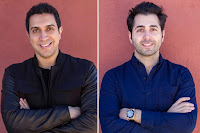Diffusion of Innovations
Application of Diffusion Theory to New Technology
(Click graph to enlarge)
Here is the “Total Universe of Potential Adopters” Theory
Tinder
“Tinder is an online dating and geosocial networking application. Users anonymously swipe right to like or swipe left to dislike other users’ profiles, which include their photo, a short bio, and a list of their interests.”
The full definition can be found here.
Tinder was first introduced in 2012, and was a fresh approach to the online dating scene at the time. The reason for this is due in part to the very simple user interface and instant gratification that comes from “matching” with another user. Roughly half of Tinders users are in between the ages of 18 and 24, whereas the rest are above the 25 age range.
The goal of this blog is to apply the original launch and the following history of Tinder to the graph we illustrated in class (above).
Pioneers
These two men on the right met in a USC and quickly hit it off with their business ventures. They started working together and eventually came up with the idea of Tinder. This idea of making the dating scene easier was adopted for the mobile phone, because any other dating sites at the time were mostly on the computer. With the growing popularity of the Iphone, they created this IOS (originally) only app. Obviously they were the first users and pioneers to this technology. Also in that category though, was the Greek life of USC’s campus. Knowing college kids would be the most stubborn to sell the idea too, they hit the hardest market first and gained popularity.
Early Adopters / Early Majority
The early adopters were 18-24 year olds, in the beginning it made up 90% of the market. That number nearly halved, as diversity increased in 17 short months. This made up the new, early majority. I think the reason the early adopters were so young, was because the word of mouth spread through friends, typically the same age group of college students. The diversity that ensued in those 17 months, of the early majority, must’ve been due to the word of mouth in the single millennial community, who spent plenty of time on their phones already. This was an easy, shallow, “hot or not” app that made hooking up much more easy. For college kids and young “professionals” in new cities, this was very appealing to meet young adults near them that they otherwise might not have run into.
Late Majority
In 2020, Tinder had 6.2 million subscribers and 75 million active users. These users swipe about 500 million times a day. Now, the age span is a larger pool, about two decades of singles. Statistically, this makes sense, as there isn’t a ton of 60 year olds trying to hook up, and most of the older generation is either taken or doesn’t know how to use a phone. The late majority is boomers mostly, who tend to get popular news a little late anyway.
Laggards
Laggards, probably the smallest group on tinder, is mostly old people trying to meet younger adults, possibly as potential “sugar babies.” These laggards don’t have a ton of access to the “up and coming” technology, so they caught this trending app very late, though it is still incredibly popular.
Downsides / Consequences
The article I’ve linked above is super interesting, about the causation of addiction, as this app involves a lot of dopamine. When you swipe and get a match, there is a false sense of instant gratification. The ease of hooking up glorifies the sexual aspect of relationships. I think this app is making people more shallow and hindering their ability to stay loyal, since it is so easy to move on to the next one now. I also think it is negatively affecting kids ability to communicate in person, and have the confidence to ask the opposite sex out for a date, in person. Without the needed personal interaction, millennials and ages younger are not equipped with certain skills needed in the real world, and even work force. The pioneers themselves say in the article that nobody is using the app looking for something real. Though some relationships come out of it, ( I speak from experience) they aren’t very lasting relationships and are very toxic. Most young people would agree with that claim. Overall, the cost benefit analysis depends on the individual’s perspective. Though some good things can come from meeting strangers online, it generally is not of huge benefit to society and causes more harm then good. No good marriage starts off with, “yeah we met on Tinder.”



No comments:
Post a Comment